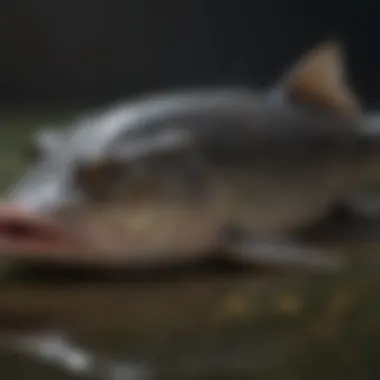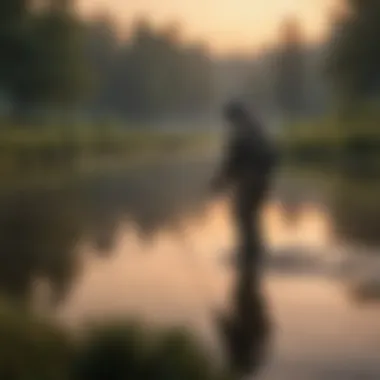Mastering Catfish Catching: Techniques & Strategies Guide


Intro
Catching catfish can be an rewarding pursuit. It involves understanding both the physical environment and the behavioral intricacies of the fish. Catfish inhabit various bodies of water, and their characteristics make them a captivating target for anglers.
This guide dives into numerous aspects of catfish catching, from fundamental techniques to biological factors that impact their catchability. It is structured to offer practical advice that enhances the fishing experience. An essential focus is given to sustainable practices in fishing, ensuring that future generations can also enjoy this engaging hobby.
Understanding these details transforms fishing from a mere recreational activity into an insightful exploration of the aquatic world.
Techniques for Catfish Catching
Choosing the right technique is vital. The basic methods include rod and reel, trotlines, and jug fishing. Each has its advantages depending on the specific fishing environment and conditions.
- Rod and Reel: Effective for beginners, this method allows for greater control. Choose sturdy gear to handle the strength of big catfish.
- Trotlines: This involves setting lines out with bait in strategic locations. Requires patience but can yield large quantities.
- Jug Fishing: Using floating jugs, ensure you can manage a larger area of water. This can be fruitful in spotting where catfish are active.
Tools and Bait
Selecting tools and bait also plays a critical role in catching catfish. Common tools include fishing rods, reels, and specialized hooks. When it comes to bait, fresh chunks of various fish or live bait like worms work well. Experimentation can lead to discovering what attracts catfish in your local waters.
Ideal Habitats
Catfish thrive in specific environments. They prefer muddy bottoms, sheltered areas, and places with ample food supply. It is important to scout for places like creek mouths, fallen trees, and deep pools.
Behavioral Patterns
Understanding catfish behavior contributes significantly to successful fishing. They are more active at night and during the early morning hours. Changes in weather can affect their feeding habits, so keeping track of atmospheric conditions is essential for planning.
Caring for the Environment
Sustainability is critical when enhancing your fishing practices. Adopt methods that protect the natural habitats of catfish. Do practice catch and release when reasonable, and adhere to local regulations on size and bag limits.
By caring for the environment, we ensure future generations reap the benefits of catfishing.
In summary, mastering the art of catfish catching involves a blend of knowledge, technique, and caring for our ecosystems. With this guide, you are well-equipped to engage more deeply in this intriguing sport.
Intro to Catfish Fishing
Catfish fishing holds a unique place in the angling community. These fish are captivating for their size, habitat variety, and bait preference. Understanding the nuances of catching catfish can significantly enhance your fishing experience.
The art of catfish fishing extends adaptability to different water environments and varying conditions. Both seasoned anglers and newcomers can benefit from honing specific techniques and knowledge tailored towards catfish behavior.
Understanding the Catfish Species
Common Types of Catfish
Several ventures can focus on catfish, given the multitude of species. The most common types include the channel catfish, blue catfish, and flathead catfish. The channel catfish, often favored for its availability and size, possesses a distinct forked tail. This feature allows immediate identification. The blue catfish is noted for its large size and strength, being a popular target for those seeking more challenging catches. Species like the flathead catfish may display distinct dark coloration, making them crucial to observe in different habitats.
The popularity of channel catfish arises not only from their size but from their adaptability in various waters. They inhabit rivers, lakes, and reservoirs, yielding ample opportunities for anglers across diverse regions. Often, evaluating the specific rivers and lakes that house these species contributes to successful fishing expeditions.
Unique attributes like resistance to different environments provide advantages. Conversely, large populations can lead to competition between fish, affecting catch rates in specific areas.
Habitat Preferences
Habitat preferences play a significant role in catfish locations. Catfish tend to explore slower-moving waters or areas with abundant cover. Underwater structures, such as logs, rocks, and channel bends, provide excellent habitats, facilitating easy ambush for prey.
The defining characteristic of such habitats not only supports healthy populations but allows anglers insight into framing their fishing strategies effectively. Understanding where to find catfish makes for better usage of time on the water.
However, environmental fluctuations can significantly change their preferences, pushing them deeper or to alternate rivers. Moving water or collapses in their nutrient-rich habitats can cause movement patterns that are essential for anglers to note.
Behavioral Characteristics
Analyzing behavioral characteristics offers a fresh perspective in mastering catfish fishing. Catfish possess nocturnal tendencies, hence, they often feed aggressively during the night. This trait is well-documented and consistently noted among avid fishers.
Catfish smell food in currents, eagerly embracing those smells particularly at dusk. By realizing this feeding behavior, anglers select optimal fishing times and bait suitable for catfish. Typically, they remain lethargic during high daytime temperatures, adopting a more passive approach.
However, ineffective response to fishing techniques can diminish catch rates, making understanding their behavior crucial. Since certain fishing approaches can excite them, recognizing their inclination helps recalibrate efforts to specific fishing spots and baits employed.
Historical Context of Catfish Fishing
Bait and Techniques Through Eras
Trace the evolution of bait and techniques utilized through time. Historical perspectives reveal variations between traditional and modern approaches. Traditional baits often utilized live or natural comparisons like answorms or minnows, or even crafted baits reflecting local fauna. With time, gurus embraced modern tactics that integrated synthetic components amplifying olfactory success for catfishing pursuits.
Bait techniques shift based on contemporary fishing environments linings. Experienced fishermen notice various approaches are influential for tailored relationships between species and bait which become essential for specific activities navigating environments.
Changing trends surrounding techniques often accompany significant gear advancements. However, while modern tools provide a competitive advantage, returning to roots realizes efficiency in select waters or times.


Cultural Significance
Cultural significance surrounding catfish fishing delves deeply. Traditions surrounding this practice in certain regions develop community importance. Avocates often cherish festivals where competitions celebrate in immense focus on bonding elements often intertwined between family or heritage.
The unique cultivation reflects versatility around different fishing grounds. The act transcends fishing itself morphing real practices in areas famed for gastronomy as specialist bars or dining ensures healthy conversations based around catching experiences throughout different groups.
As audio recordings of stories echo between fishing families, mythos discharge learning points tremendously fascinating.
Essential Gear for Catfish Fishing
Catfish fishing requires specific gear to be successful. The right tools allow for precision and enhance the overall fishing experience. Different catfish techniques will also dictate the type of gear you need. Proper equipment can save time and improve the rate of catch. It is crucial to invest in suitable gear and understand how each component functions.
Choosing the Right Rod and Reel
Length and Power Considerations
Rod length and power are essential in catfish fishing. A longer rod offers wider casting distance, while power classification affects the fish's ability to pull on the line. A medium-heavy rod is often preferred as it balances versatility and strength. These rods allow you to catch a variety of catfish sizes effectively. It is critical to match the power to your targeted species and fishing environment.
Reel Types: Spinning vs.
Baitcasting
There are two primary types of reels: spinning and baitcasting. Spinning reels are simple and user-friendly, making them an ideal choice for beginners. Baitcasting reels, on the other hand, allow for better accuracy. They are generally used by more experienced anglers who want tighter control on their bait. Deciding between these options depends on your fishing style and comfort.
Hooks and Lines
Best Hook Types for Catfish
Choosing the right hooks is vital. Circler hooks are popular among catfish anglers due to their unique design that ensures a more secure catch. They bury into the catfish's mouth more effectively. They come in various sizes, allowing for adjustments based on the bait and targeted catfish species. Ensuring that hooks are strong enough can reduce waste and increase success.
Line Strength and Material
Line strength is a key component. Monofilament lines are flexible and easy to use, while braided lines offer excellent sensitivity and strength. For catfish, a recommendation is to use lines with a tensile strength of at least 30 pounds. This measure helps ensure durability against larger fish. Both type of line have specific advantages, and a well-matched line enhances fishing efforts.
Baits: Natural vs.
Artificial
Popular Natural Baits
Natural baits such as live worms, shad, or chicken livers often yield higher success rates. Catfish are bottom feeders and are easily attracted to these types of baits. Natural baits usually work best because they mimic the catfish's standard diet, thus enticing more strikes. Over time, you will come to understand which natural options yield the best results in specific locations.
Effective Artificial Options
Artificial baits have gained immense popularity. They are convenient and can be tailored to simulate the movements of real fish. Jigs and soft plastics tend to be very effective in imitating prey, drawing catfish in. However, some anglers find that the hit rate is lower when getting used to artificial baits. Be prepared to experiment to understand the best use case for your pursuits.
Keep in mind that understanding gear contributes to enhanced outcomes in catfish fishing. Each element – from rods and reels to lines and hooks – serves its purpose and influences overall success. By investing in quality gear and learning its features, you increase your odds for substantial catches.
Techniques for Catching Catfish
Catching catfish requires specific knowledge and practical experience in the right techniques. This section is essential for anyone looking to improve their catfishing outcomes. Techniques vary by location, targeting methods, and the behaviors of catfish. Therefore, understanding the various techniques permits anglers to select suitable methods for their fishing adventures. Several approaches to catching catfish include here: bank fishing, boat fishing, jug fishing, and trap fishing. Each of these techniques has distinct benefits and considerations, contributing to the overall success of the fishing endeavor.
Bank Fishing
Best Locations Along Shorelines
Choosing the right locations for bank fishing is crucial. Successful anglers often consider deep pools, bends in rivers, and weed beds. These locations hold water depth conducive to catfish activity. Their structure provides shelter and lays opportunities for fishing success. Also, transitioning areas—where shallow water meets deeper holes—are popular spots. Certain banks can facilitate easy casting and accurate placement of bait.
Locations rich with natural cover enhance catch rates significantly. Surrounding vegetation often attracts prey to bait; that is why it's beneficial to target those areas.
Effective Techniques and Tips
Utilizing effective techniques is as necessary as finding favorable locations. Patience is a valuable form of skill in bank fishing. Casting parallel to the bank can often lead to larger catches. Moreover, it's vital to ensure the bait stays in the lucrative zone for as long as possible.
Using heavier weights can assist in keeping the bait at the bottom, directly where catfish patrol. Gradually working at different water depths helps to find the level where catfish hunt. Staying quiet and keeping movements limited is imperative; excessive noise can spook fish, reducing success rates on the water.
Boat Fishing
Preferred Fishing Areas
When fishing from a boat, understanding preferred fishing areas influences the outcomes. Techniques used differ when anglers are on a moving vessel. Targeting specific areas, such as river channels or lake humps, has shown effectiveness.
Cover features like fallen trees or submerged rocks can make for advantageous environments. Locating these structures can lead to increased catfish activity, amplifying one's chance to make consistent catches.
Setting Up Your Boat for Success


The setup of a boat matters greatly to catfish fishing. Organizing gear, preparing rod holders, and ensuring easy access to baits prevent stressful situations. Utilize anchored or drifting methods based on specific locations and water conditions.
Positioning the boat parallel to the desired fish areas fosters strategic casting angles. By maneuvering effectively, anglers can cover more surface area and spot variations in depth. Also, having an extra person improves efficiency, as someone can focus on retrieving catfish as needed.
Jug Fishing
Setting Up Jug Lines
Jug fishing is a skillful method for catching catfish that depends on effective setup. Using jugs as bobbers allows for opportunities along expansive water spaces. Making certain that lines are noticeable via bright colors or flags enhances visibility.
Strategic placement, such as baiting in areas known for fish movement, results in advantageous situations. Keeping track of each jug's location prevents loss of equipment. Each jug should have adequate flexibility to adapt as conditions change.
Best Practices for Success
Practicing successful jug fishing means continually monitoring jugs and adapting methods. Using appropriate bait ensures attractivness to the targeted catfish species. Sometimes natural bait is superior to artificial options, depending on the situation currently unpliable.
Regular communication with fishing partners and documenting successes or failures further improves techniques. Balance between trapping ethics and nearby adventures also lies key in achieving consistent results.
Trap Fishing
Types of Traps to Use
Trap fishing incorporates various types of traps suitable for targeting catfish. Common traps include nets and specially designed wire-frame styles. Each of these types offers distinct advantages.
The designs of traps seek to minimize injuries while retaining flow. Selecting the trap based on species requirements ensures it fits well with game and their behaivors. Additionally, quality traps save time on the water and can be more productive than casual fishing styles.
Effective Baiting Techniques
针对有效诱捕技巧,内容/其实涉及引导鱼儿不到具体,结构 /大致包含 生物的一些相关技巧。 选择合适诱饵相DV突出入品个限制。“各鱼很多提供收获多不良影响的的内容局都有绝的步的排谏。”
Setting strong scents draws in instead of just handing a barely enticing bait across the water. Care for cleanliness ensures a bait’s effectiveness and sustainability over multiple uses. Regularly checking and renewing bait contributes positively to achieving ample catch levels.
Successful catfishing techniques require blending traditional knowledge with practical experience. By investing time in understanding location-specific behaviors, techniques evolve with experience, resilience builds the fishing wardrobe. Supportive thought research surroundings takes people further, horffing together results.
Seasonality and Timing
Understanding the seasonal patterns and timing directly impacts your success in catfish fishing. Various aspects of catfish behavior shift according to the time of year and time of day, calling for adaptive strategies. Therefore, mastering the seasonality enables anglers to optimize their fishing efforts. Different seasons offer specific characteristics and challenges that can be exploited for greater success.
Understanding Catfish Behavior by Season
Spring Tactics
In spring, catfish become increasingly active as temperature rises. During this time, they spawn, making them more aggressive compared to other seasons. This behavior is linked specifically to warmer waters and the availability of food sources. Common tactics include utilizing strong-smelling baits such as cut bait or stink bait to attract them.
The characteristic highlight of spring fishing is increased fish activity near shorelines and lighter covers. It becomes a popular choice for novice anglers due to the availability of catfish in shallower waters. The unique feature of targeting spawning males often leads to catches that are both more abundant and larger.
However, this season may present a disadvantage in navigating murkier waters due to algae. Anglers must be cautioned to varies their approaches accordingly.
Summer Strategies
Summer is inherently marked with challenging fishing conditions. Higher temperatures push catfish deeper into cooler waters during midday. This aspect invites anglers to adapt their methods. Evening and night fishing generally becomes the best strategy, when the fish return to more shallow areas to hunt.
The key characteristic of summer strategies lies in the use of sensitive bait setups, using method like bottom fishing with heavier weights. Night fishing also increases opportunities of successful catches. Moreover, choosing cooler days to fish can yield better results.
A unique feature of this tactic is integrating aquatic worms, which are effective bait during the summer. However, it can create disadvantage due to heat affecting prolonged fishing sessions, leading many to fish less.
Fall Approaches
As temperatures start to decline, catfish enter a feeding frenzy in preparation for winter. The turbid water from autumn winds could complicate angling but can also be beneficial. The movement patterns change slightly, where catfish will chase bait closer to the surface.
A distinctive quality of fall fishing is prevalent active feeding behavior as fish are stocked up for winter. Its popularity arises from cater to a vastly adaptive angler base from casual to seasoned fishers. Trickling in a variety of baits can result in diverse captures.
However, reducing daylight hours might retrieve fewer anglers to the methods they find most productive. Thus, appropriate planning is necessary during this time.
Winter Considerations
Winter can pose substantial challenges. Reduced movement and inactivity during cold spells characterize catfish in winter. Their behaviors become more predictable, often opting for the deepest areas of water.
The key aspect of winter fishing is minimizing disturbance. Concentrating bait drops into known concentrations of fish becomes paramount. Live bait is particularly popular but should be sharply reduced, giving fish time to register interest.
The unique feature of this tactic includes using electronics or jigging techniques that can produce notable results for the patient angler, despite the often permanently household grind.
Attaining fishing knowledge during winter involves disadvantages including freezing factors that make attending difficult and potentially low hook rates, but serious enthusiasts often find the results rewarding enough to merit perseverance.
Optimal Times of Day for Fishing


Midday vs.
Early Morning and Evening The timing of your fishing efforts makes a significant difference. Early morning or late evening often delivers higher chances of successful catches. During these hours, it is more likely that catfish engage actively in the feeding behaviors.
Midday can lead to reduced catch success as practical angles demand adjusting location and bait properties. Recognizing this pattern aids in raising themselves for greater catches throughout the day
Alternative methods involve still fishing with balance dynamic baits during farms afternoon hours. Through establishing activity peaks through consistent practice, substantial rewards can appear greater – elevating the entire fishing experience.
Influence of Moon Phases
Cycling through moon phases can dramatically influence fish behaviors. Hot moon activities suit-wrap-appropriate wildlife patterns leading to active or heightened characteristics.
A well-tracked scenarios will include major phases like new moon markings, where catfish can become actively premeditated.
Monitoring moonrise and moonset creates not opportunities specifically using a mix bait – interjecting prominent behaviors visibly reinforces catfish characteristic adaptations. Its culminating features enable angler skills significantly by discrepancies based on confident leverages.
However, erroneous factors exist as community observations appear truly then diminish determination for these peculiar data spikes observed amongst anglers enthusiastical self-responses.
Conservation and Ethical Fishing Practices
Conservation and ethical fishing practices are crucial for the sustainability of catfishing as a sport and for protecting aquatic ecosystems. As both amateur and professional anglers engage in catfish fishing, the need to uphold responsible practices becomes increasingly important. Without these practices, we risk diminishing fish populations and damaging the natural habitats where catfish and other aquatic life thrive. Educating anglers about ecological balance and stewardship ensures the correlative health of waterways for future generations.
Maintaining awareness about fishing ethics can lead to healthier fish populations, enhanced fishing experiences, and a reduction of human impact on the environment.
Understanding Local Regulations
Regulations vary widely between locations, emphasizing the necessity of awareness for every angler. Local regulations typically establish the guidelines that govern fishing practices.
Fishing Licenses and Limits
Fishing licenses represent a form of regulation actively designed to manage fish populations. Obtaining a fishing license is fundamental before heading out on the water. These permits ensure that anglers contribute to conservation efforts financially, hence advocating for sustainable fishing.
They help keep track of how many people are engaging in fishing and limit catches to protect vulnerable populations. The best part is licenses often require minimal fee while ensuring compliance with regional laws.
However, there are potential drawbacks for anglers unfamiliar with regulations. They may inadvertently exceed limits if they do not fully understand what is enforced in their favorite fishing spots. Hence, research and adherence are essential to mitigate any unintentional violations.
Protected Species Awareness
This refers to knowing which catfish types or other aquatic species are under protection due to their declining populations. Protected species status may mean restricted catch limits or total prohibitons on harvesting certain fish. Underestimating the implications of protected species can lead to serious penalties, making awareness of these guidelines essential for all.
Highlighting this aspect promotes responsible angling, serving these species and environments but providing informative growth opportunities for concerned fishers.
The encouragement to protect diversity helps increase overall biodiversity. a mixed environment stays healthier while attracting various creatures for future fishing endeavors. Ignorance in regard to these laws can create serious consequences for local ecosystems and the anglers themselves.
Sustainable Fishing Methods
Sustainable fishing methods ensure that fish populations and aquatic habitats remain healthy amid active leisure activities. Implementation of these techniques not only contributes to conservation but also promotes a culture of responsibility among anglers.
Catch and Release Techniques
Implementing catch and release is a significant approach in ethical fishing practices. On top of giving back to fish populations, the technique allows anglers to experience the thrill of catching while also preserving aquatic biodiversity.
This practice encourages populations to thrive, ultimately improving the fishing experience over time. Newer methods promote minimal stress for the fish, such as using proper handling techniques or specialized hooks created for easy release.
Nonetheless, commitment to best practices must be continuous to realize the ultimate benefits. While some catch-and-release practices may lead to discomfort for novice anglers, the long-term ecological advantages outweigh any negligible immediate effects for the adventurous fisher.
Minimizing Environmental Impact
Reducing the environmental impacts caused from angling successfully contributes in benefiting local ecosystems. Techniques include proper waste disposal from fishing activities and considering the operational aspects of your boat if utilized. Adopting low-emission engines or non-toxic materials further suggests a growing consciousness toward academia supported standards, As they showed choice take constrained living conditions.
Moreover, minimizing the straying of harmful littering supports a cleaner natural habitat. One small act of responsibility aggregates larger ecological returns. When anglers proactively embrace the principle of tailoring their approaches together while learning about sustainable habits, the sector promptly undergoes profound evolution.
End and Resources for Further Learning
The conclusions drawn from exploring catfish catching provide not just insights into the art of fishing but also deeper awareness of sustainable practices. Learning various techniques, understanding the species, and recognizing ethical responsibilities in fishing opens avenues for improved practices in the sport. These best practices contribute to long-term benefits, not just for fishers but for ecosystems. A responsible approach to catfish fishing encourages preservation of species, ensuring that future generations can also appreciate the excitement of catching these fish.
Recap of Key Points
- Understanding Catfish Species: Knowledge of common catfish types, their habitats, and peculiar behaviors is crucial for effective fishing strategies.
- Essential Gear: Selecting the right rod, reel, hooks, and baits optimization can significantly affect catch rates.
- Techniques for Catching: Employing proper methods like bank fishing, boat fishing, jug fishing, and trap methods outline effective strategies.
- Seasonality and Timing: Mastery over seasonal behavior and the best times of day includes honing skills for various conditions.
- Conservation Practices: Emphasizing a balance between fishing practices and environmental health promotes responsible trophy hunting and catch-and-release practices.
Recommended Books and Websites
For those seeking to dive deeper into catfishing, the following resources present useful information:
- Books
- Websites
- Catfish: The High Life and Hard Times of a Fishing Guide by Brad W. McFarland
- The Complete Guide to Catfish Fishing by Bob D. Mason
Utilizing these resources will enhance both practical fishing skills and understanding of the philosophies behind sustainable practices.







